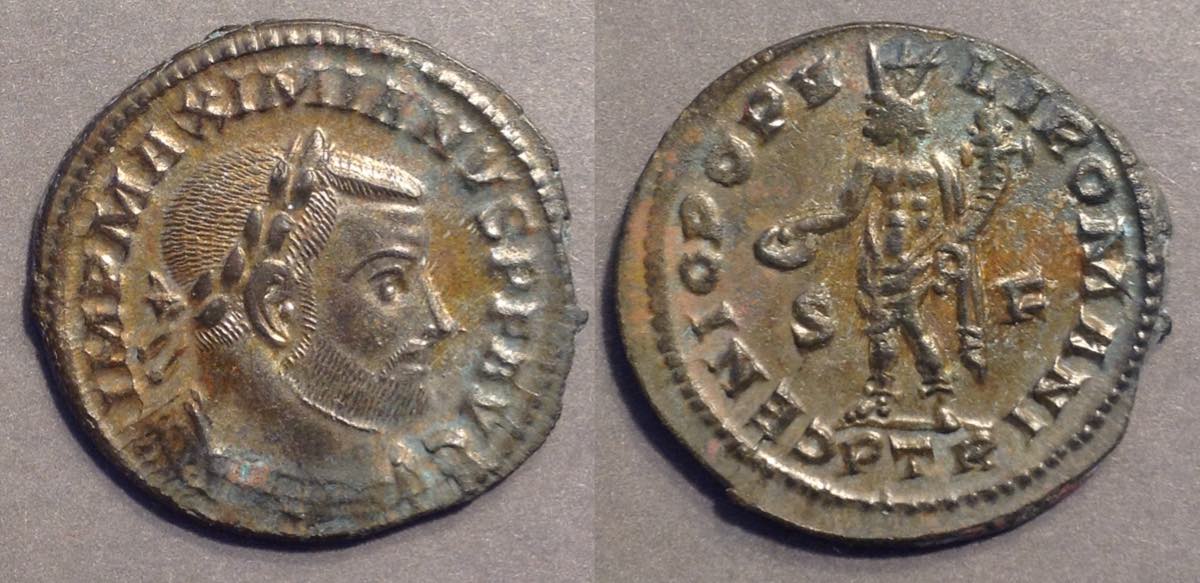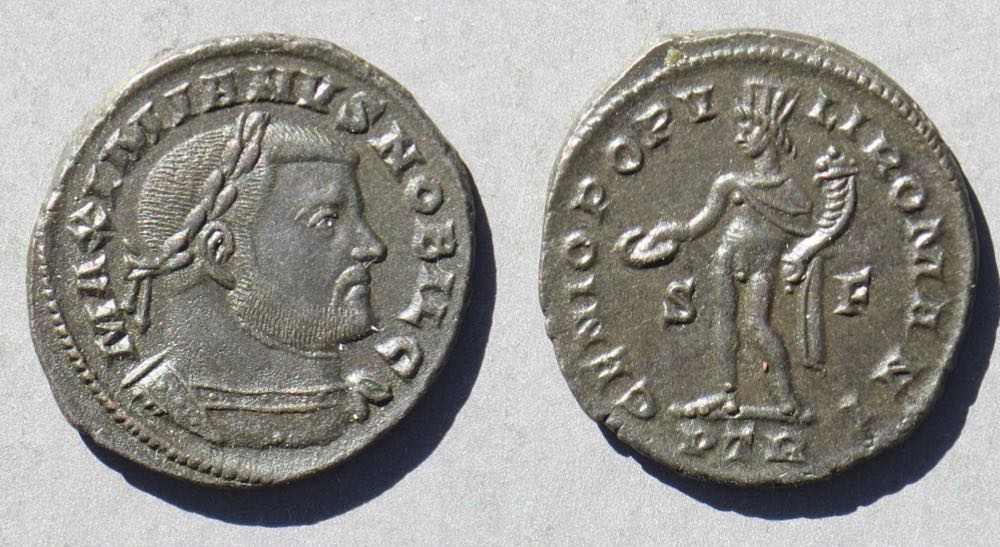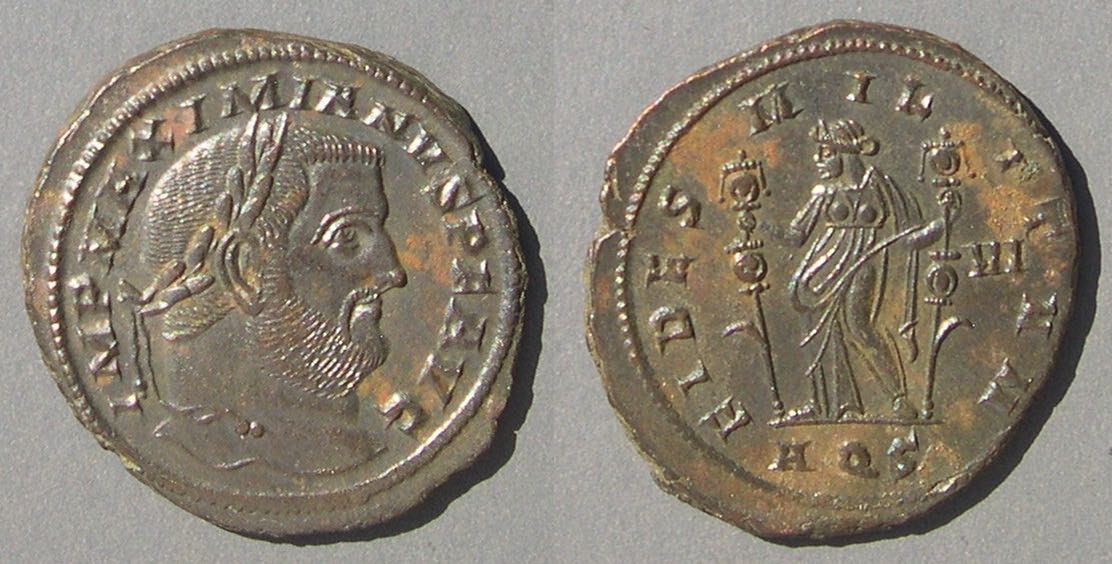Coin 3:
 Maximian, retirement issue, after May 1, 305.
27 mm. 9.46 grams.
Maximian, retirement issue, after May 1, 305.
27 mm. 9.46 grams.
DN MAXIMIANO FELICISSMO SEN AVG
PROVIDENTIA DEORVM QVIES AVGG
S F in fields (Saeculi Felicitas?) [We don't know what "S A" refers to on Coins 1 and 2.]
PTR in exergue
RIC VI Trier 676b, "1 May 305 - early 307"
 Galerius (not Maximian, in spite of the obverse legend)
Galerius (not Maximian, in spite of the obverse legend)
Struck at Trier, a mint of Constantius and then of Constantine.
28-27 mm. 9.19 grams.
IMP MAXIMIANVS P F AVG
This is a coin of Galerius, not Maximian. This is clear from both the portrait (which does not have the distinctive nose of Maximian) and the co-rulers in the same issue.
GENIO POPVLI ROMANI
Genius with loins draped.
S F in fields
PTR in exergue
RIC VI Trier 652b. "1 May 305 - early 307".
This group is shared by Galerius as Augustus with Constantius as Augustus, Constantine as Caesar, Maximinus II as Caesar, and, retirement issues of Diocletian and Maximian (above).
(Go to a page on how to distinguish coins of Maximian and Galerius. It overlaps this page.)
The sequence of events. Maximian became an Augustus in 286 and Galerius became a Caesar in 293.
The events critical to these issues were:
1) May 1, 305, Maximian retired and Galerius was promoted to Augustus. Maximian's titles "IMP" and "AVG" lapsed. Galerius, who had been a Caesar, assumed those titles, so his legends had those titles in common with the legends Maximian had used. Coins for the retired Maximian had "retirement" legends with the new inferior titles "DN" (Dominus Noster = Our Lord) and "SEN AVG" (Senior Augustus) (Coin 3).
2) Late in 306 Maximian came out of retirement (his "second reign") and assumed the titles "IMP" and "AVG" again. Constantine, who was only Caesar, at first not want to acknowlege Maximian as an active Augustus above him (Coin 5 below).
3) In summer 307 Constantine and Maximian came to an agreement where each recognized the other as (active) Augustus. This was awkward for mints of Constantine who was trying to remain on good terms with both Maximian and Galerius. Constantine was already using the name "MAXIMIANVS" for Galerius (Coins 2 and 4), so what name could he use for Maximian? Constantine solved this conundrum by minting for Maximian with the long version of his name (Coin 1) and using the short version for Galerius (Coin 2).
Maximian's second reign. In late 306 Maximian was invited out of retirement by his son Maxentius who had usurped power in Rome (Coin 10). Constantine, at the time only Caesar, did not want to be ranked below an Augustus, so at first he went only half way to recognizing this event by minting for Maximian with his retired titles "DN" and "S AVG" on the obverse but with the GENIO POP ROM reverse which was not a retirement type.
Coin 5: A coin minted by Constantine for Maximian that splits the difference between recognizing him as fully retired (Coin 3) or as fully active (Coin 1).
 Maximian
Maximian
25-24 mm. 6.61 grams.
DN MAXIMIANO P F S AVG (notice the distinctive nose and the retired titles in the dative case)
GENIO POP ROM
PLN
RIC London 90 "c. summer 307," i.e. before Constantine recognized Maximian as an active Augustus.
Conclusion. Maximian and Galerius had similar names. Coins of both included MAXIMIANVS in their legends. On some coins parts of the first three names of "Marcus Aurelius Valerius Maximianus" are used to distinguish them.
That is a summary of the story of Maximian's long legend. Continue only if you would like to see the related coins cited above.
Go to the page of links to other pages about the tetrarchal period. Go to the main Table of Contents of this whole educational site.
Additional related coins.
Coin 6: Maximian with the legend "IMP MAXIMIANVS PF AVG" later used by Galerius (Coins 9 and 2).

Maximian
28-25 mm. 9.11 grams.
IMP MAXIMIANVS PF AVG
Note the distinctive nose.
GENIO POPVLI ROMANI
Genius standing left, naked, with flaming altar left
AQS in exergue
RIC Aquileia 27b "c. 299"
Coin 7: An early issue of Maximian with a long version of his name.

Maximian
Radiate, a.k.a. "aurelianus" a.k.a "antoninianus".
21 mm. 4.21 grams.
IMP C M AVR VAL MAXIMIANVS PF AVG
IOV ET HERCV CONSER AVGG
TR in the middle field
XXI in exergue
RIC VI 624 Tripolis mint. "285-290," but likely 286-287.
Coin 8: Galerius as Caesar with the name MAXIMIANVS. Maximian was never just Caesar on coins--he was already Augustus on his first coins--so this must be of Galerius.
 Galerius as Caesar
Galerius as Caesar
28-26 mm. 9.66 grams.
MAXIMIANVS NOBIL C (C for Caesar)
GENIO POPVLI ROMANI
S in left field, F in right field
PTR in exergue
RIC Trier 594b "c. 303- 1 May 305" (i.e. the last issue before becoming Augustus)
 Maximian.
Maximian.  Galerius as Augustus, autumn 307- end of 308.
Galerius as Augustus, autumn 307- end of 308. Maximian, retirement issue, after May 1, 305.
Maximian, retirement issue, after May 1, 305. Galerius (not Maximian, in spite of the obverse legend)
Galerius (not Maximian, in spite of the obverse legend) Maximian
Maximian


 Galerius as Augustus
Galerius as Augustus Maximian
Maximian Maximian
Maximian